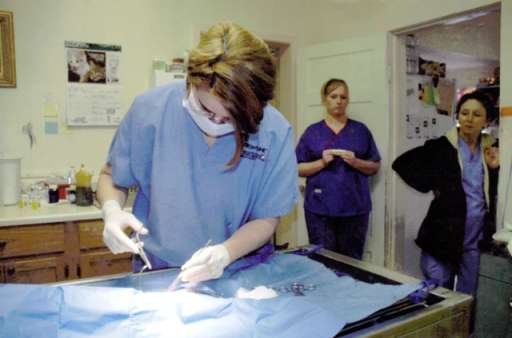Spaying your female dog was a rare practice before the 1970s when widespread dog euthanizing and overpopulation in shelters brought out the need to check uncontrolled dog breeding. Today, spaying your female dog is commonplace if you don’t intend to breed your pet. But does every dog owner think they should spay their female dog?
Dog experts recommend spaying your female dog because there are health benefits associated with surgical sterilization, such as diabetes and cancer prevention. However, recent studies have highlighted health risks related to spaying your dog, including joint disorder and some cancers.

This article explores the good and the bad of spaying your female dog according to existing research. If you are also wondering at what age you should spay your female dog, you’ll find the answer right here!
What Happens When Your Dog is Spayed?
Spaying is the surgical procedure performed on a female dog to sterilize the pet. Two different procedures can be performed when your female dog is spayed:
- Ovariohysterectomy – the surgical removal of the ovaries and the uterus.
- Ovariectomy – the surgical removal of the ovaries only.
Spaying is a major operation, and veterinarians usually follow a precise procedure when it is done. Here’s what happens when your female dog is spayed:
- The vet performs pre-operation blood tests on your dog. This helps the vet determine whether your pet is healthy enough to undergo the procedure.
- An intravenous catheter is inserted to give the anesthesia. The catheter is also used to administer fluid therapy to the dog during the operation.
- A breathing tube is inserted into the dog’s trachea once the anesthesia takes effect. This tube delivers oxygen straight into your dog’s lungs.
- An incision is made at the dog’s belly button (below the umbilicus) to remove the ovaries and uterus. Only the ovaries may be removed as per the vet’s recommendation.
- The vet sutures the operation spot to close the wound. The wound is usually closed with absorbable sutures, so you don’t need to bring your pet for suture removal.
After the procedure, your dog may be kept at the clinic until the veterinarian considers it safe to bring your pet home. Observing your dog for a couple of days is also important because spaying can come with post-operation risks, including:
- Infection or inflammation at the operation spot.
- Fluid collection or bleeding under the skin of the surgery spot.
- Opening of the operation incision.
These risks can be minimized or prevented by keeping your dog quiet (without much movement) and preventing the dog from licking the surgery spot using an Elizabethan collar.
Why You Should Spay Your Female Dog: The Advantages
Generally, the decision to spay a female dog can be made for one of these reasons:
- Health reasons.
- Behavioral factors.
- To check the dog population.
Let’s explain these reasons in detail.
Spaying your Dog has Health Benefits
There is a consensus that a spayed dog has a better quality of life when it comes to health. Health benefits associated with spaying your dog include:
Diabetes Prevention
It’s no longer speculation that female dogs are at a greater risk of diabetes than their male and intact female counterparts. This has been proven by a number of studies over years.

The increased risk for diabetes in female dogs is associated with an ovarian activity. In other words, female dogs produce high progesterone levels and release the growth hormone during the heat season (estrus). Progesterone negatively impacts insulin production and utilization, predisposing your dog to dioestrus-induced diabetes.
Spaying your dog stops estrus and, consequently, the risk for diabetes. A study has suggested that diabetes remission can be obtained in female dogs within 39 days after ovariohysterectomy.
Prevention of Mammary Cancer
Dog mammary cancer is the most common type of tumor in intact females and has a 50% prevalence. Information by the American College of Veterinary Surgeons indicates that:
- Approximately 24% of intact female dogs will get mammary tumors at some point in their life.
- Mammary tumors are more prevalent in intact female dogs than in those spayed.
- Mammary tumors are more common in dogs spayed after the age of 2 years.
- Mammary tumors are more common in some breeds, including Dachshunds, Poodles, and Spaniels.
- 50% of dog mammary tumors are malignant (not necessarily fatal).
- The risk of mammary tumors is only 0.5% for dogs spayed before their first heat (6 months of age), 8% for those spayed after their first heat, and 26% for dogs spayed after their second heat.
These statistics leave no doubt about the health benefits of spaying your female dog.
Prevention of other diseases
Other conditions that can be prevented by neutering your female dog include:
- Ovarian and uterine cancer.
- Pyometra, a uterine infection.
Spaying your Dog Helps with Behavioral Problems
During the heat period, female dogs can portray behavior that their owners deem disturbing or unhygienic for their families’ living conditions. These behaviors include howling, crying, bloody virginal discharge, and running away to look for a mate.
Since spaying your dog stops the occurrence of estrus, these behaviors are curbed with spaying.
Spaying your Dog Checks Dog Overpopulation
Dog overpopulation is real and a huge problem. According to the Humane Society of the United States, about 1 million adoptable dogs are put down each year in the US. This is because dog shelters have more pets than the people willing to adopt them.
Dog overpopulation happens for two reasons:
- Dog ownership by people who can’t guarantee to keep them to the end.
- Dog breeding without ensuring the chance of finding a home for the puppies.
For these reasons, spaying your dog is greatly encouraged to reduce uncontrolled reproduction and dog overpopulation.
The preceding gives you positive reasons for spaying your dog. However, it’s also important to note that spaying your female dog can come with some downsides.
Potential Risks of Spaying Your Female Dog
As stated earlier, the general recommendation is that you should spay your dog to enhance the pet’s health and quality of life. However, there is also developing evidence to support the need to delay your dog’s spay surgery until the pet has attained maturity. Some research-backed reasons also discourage spaying your dog altogether.

Here are the research-supported reasons why you should consider delaying your dog’s spaying age or not performing the surgery at all:
(Early) Spaying Could Predispose your Dog to Some Diseases
Over the many years of dog domestication and ownership, professionals and dog owners have had a general idea that it is best to spay or neuter your dog before the age of maturity. For female dogs, this means before their first heat, which typically happens around the age of 6 months.
Research now suggests that this practice could be detrimental to your dog’s health. To simplify complex research, the findings below suggest you might be better off delaying your dog’s age of neuter or spay or indefinitely postponing it all together:
- Spaying (and neutering) is associated with increased risks for joint disorders. The increased risk for joint disorders is especially noticed in dogs neutered before 6 months of age. The joint disorders include hip & elbow dysplasia and cranial cruciate ligament rupture.
Also, the risk for these joint disorders is mainly found in large dog breeds but not in smaller ones. However, there are variations in large breeds. For example, Irish Wolfhounds and Great Danes do not show any increased risk for joint disorders after spaying or neutering at any age.
- Spaying can come with higher risks for certain cancers in some dog breeds. An example of breeds predisposed to spay/neuter-related cancers is the Golden retrievers, where the risk for the cancers is 2-4 times higher in spayed dogs compared to intact dogs. Cancer risks associated with spay (and neuter) include mast cell tumor, hemangiosarcoma, lymphoma, and osteosarcoma.
Spayed Dogs Can Show Behavioral Problems
It is often presumed that neutering or spaying your dog tames aggression, especially in male dogs. It appears that this is just a presumption.
Research on dog aggression and neuter/spay has repeatedly shown the opposite: neutered or spayed dogs are more aggressive!
Here are some study findings related to dog spaying and increased aggression:
- Dogs spayed before or at 12 months had a significantly higher aggression score than intact dogs. (Source)
- Spayed females were more likely to show aggression towards children and adults at home, towards strangers approaching the pet or the house, towards people approaching the owner, when handled, during meals, in restricted space, when disciplined, and even for no apparent cause. (Source)
- A younger spay age was associated with increased aggression towards strange people and dogs. (Source)
There’s still a lot of ongoing research about the pros and cons of neutering or spaying your dog. Watch this space for the most recent findings!
Spaying your Female Dog FAQs
Before completing this article on whether you should spay your female dog, a few questions complete the above information on the topic.
What Age Should a Female Dog be Spayed?
Dog experts do not make a blanket statement on when you should spay your female dog. This is because there are advantages associated with early spayings, such as reducing the risk for diabetes, but there are also related risks such as predisposition to joint disorders. As such, the decision about when it’s best to spay your dog should be made by you in consultation with an accredited vet.
How Much Is It to Spay a Dog?
The cost of spaying a dog can vary from a low of $50 to a high of $500. This wide variation in dog spay costs can be determined by the following factors:
- The clinic where you take your dog (clinics with donation subsidies are cheaper).
- The dog’s age, size, and breed (older dogs and those from larger breeds may cost more).
- The type of procedure (ovariohysterectomy or ovariectomy).
- Dogs with preexisting health conditions may cost more.
Note that you may find a “free spay and neuter near me” service with animal welfare organizations or animal shelters. Some local councils may also have free neuter and spay services, such as the one in Maryland.
We recommend doing a thorough research and working with your dog’s vet to determine what best fits your pocket.
